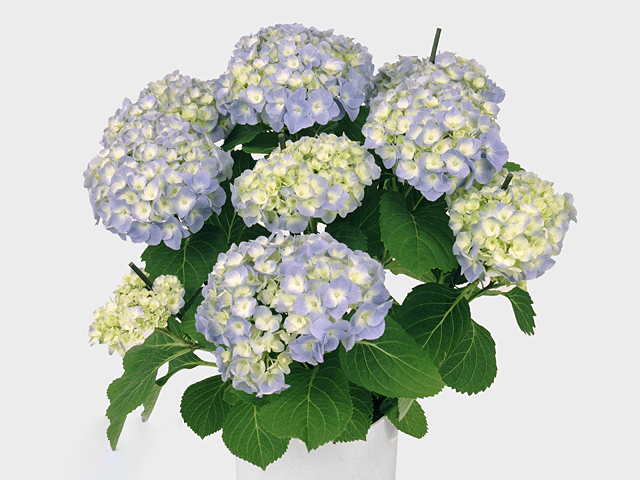Hydrangea macrophylla 'Bodensee'

| Flower type | Single |
| Winter hardness | Good (USDA-zone 5, 6) |
| Flower color | Blue-medium blue-098B |
| Flower diameter | 2,5 - 3 cm |
| Plant height | 20 - 30 cm |
| Inflorescence | Globose |
| Leaf size | 10 - 15 cm |
| soil pH requirement | Neutral (pH 6,5 - 7,5); Slightly acidic (pH 4,5 - 6,5); Alkaline (pH > 7,5) |
| Light conditions | Semi-shades; Sunny |
| Flower, secondary color(s) | Purple-light blue violet-085B |
| Toxicity (if consumed) | Not or barely |
| Moisture requirements | Well-drained; Moist |
Hydrangea macrophylla 'Bodensee', also known as the Bodensee Hydrangea, is a beautiful flowering plant that is admired for its stunning blue flowers. This particular hydrangea is a single-flowered variety and is known for its winter hardiness, making it suitable for USDA zones 5 and 6.
The flowers of the Bodensee Hydrangea are medium blue in color, with a shade that can be likened to the Pantone shade 098B. These flowers have a diameter of 2.5 to 3 cm, adding a pop of color to any garden or landscape. The plant itself grows to a height of 20 to 30 cm, making it a compact and versatile option for smaller spaces.
One of the characteristics that make the Bodensee Hydrangea stand out is its globose inflorescence, which refers to the rounded shape of the flower cluster. This creates a visually appealing display when the plant is in full bloom. The leaves of this hydrangea are also quite large, ranging from 10 to 15 cm in size.
In terms of soil pH requirements, the Bodensee Hydrangea can thrive in neutral soil conditions with a pH ranging from 6.5 to 7.5. It can also tolerate slightly acidic soil with a pH of 4.5 to 6.5, as well as alkaline soil with a pH above 7.5. This adaptability allows gardeners with a variety of soil types to successfully grow this hydrangea.
When it comes to light conditions, the Bodensee Hydrangea can tolerate both semi-shaded and sunny areas. This makes it a versatile option for gardens that may have areas with varying light levels. Additionally, the secondary color(s) of the flowers are described as a purple-light blue violet, adding depth and interest to the overall display.
One of the advantages of growing the Bodensee Hydrangea is that it is not highly toxic if consumed. However, it is always important to exercise caution and keep plants out of the reach of pets and children. This hydrangea has been reported to cause gastrointestinal discomfort if ingested.
To ensure the optimal growth of the Bodensee Hydrangea, it is important to provide it with well-drained soil. This helps prevent waterlogging, which can be detrimental to the plant's health. Additionally, maintaining a slightly moist soil condition is ideal for this hydrangea, allowing it to thrive and produce vibrant blooms.
In conclusion, the Bodensee Hydrangea is a stunning plant that offers beautiful blue flowers, compact growth, and winter hardiness. With its adaptability to varying soil pH levels and light conditions, it can be successfully grown in a variety of gardens. Its low toxicity and moisture requirements make it a popular choice among gardeners looking for an easy-to-care-for and visually appealing plant. Whether in containers or as part of a larger landscape design, the Bodensee Hydrangea is sure to add beauty and charm to any outdoor space.
Market availability index by month:
| Jan. | Feb. | Mar. | Apr. | May | Jun. | Jul. | Aug. | Sep. | Oct. | Nov. | Dec. |
|---|---|---|---|---|---|---|---|---|---|---|---|
| 3 | 3 | 3 | 4 | 4 | 3 | 2 | 2 | 2 | 2 | - | 1 |